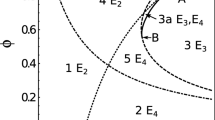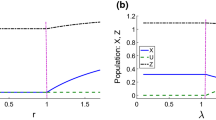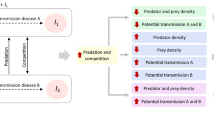Abstract
Invasive species are a significant cause of bio-diversity loss particularly in island ecosystems. It has been suggested to release pathogenic parasites as an efficient control measure of these mostly immune-naïve populations. In order to explore the potential impacts of such bio-control approach, we construct and investigate mathematical models describing disease dynamics in a host population that acts as a predator embedded in a simple food chain. The consequences of Feline Immunodeficiency Virus (FIV) introduction into a closed ecosystem are addressed using a bi-trophic system, comprising an indigenous prey (birds) and an introduced predator (cats). Our results show that FIV is unlikely to fully eradicate cats on sub-Antarctic islands, but it can be efficient in depressing their population size, allowing for the recovery of the endangered prey. Depending on the ecological setting and disease transmission mode (we consider proportionate mixing as well as mass action), successful pathogen invasion can induce population oscillations that are not possible in the disease-free predator–prey system. These fluctuations can be seen as a mixed blessing from a management point of view. On the one hand, they may increase the extinction risk of the birds. On the other hand, they provide an opportunity to eradicate cats more easily in combination with other methods such as trapping or culling.
Similar content being viewed by others
References
Anderson, R.M., 1982. Theoretical basis for the use of pathogens as biological control agents of pest species. Parasitology 84, 3–33.
Anderson, R.M., May, R.M., 1981. The population dynamics of microparasites and their invertebrate hosts. Philos. Trans. R. Soc. Lond. B 291, 451–524.
Anderson, R.M., May, R.M., 1986. The invasion, persistence and spread of infectious diseases within animal and plant communities. Philos. Trans. R. Soc. Lond. B 314, 533–570.
Atkinson, I.A.E., 1988. Opportunities for ecological restoration. N.Z. J. Ecol. 11, 1–12.
Atkinson, I.A.E., 1989. Introduced animals and extinction. In: Western, D., Pearl, M.C. (Eds.), Conservation for the Twenty-First Century, pp. 54–75. Oxford University Press, Oxford.
Auger, P., Mchich, R., Chowdhury, T., Sallet, G., Tchuente, M., Chattopadhyay, J., 2009. Effects of a disease affecting a predator on the dynamics of a predator–prey system. J. Theor. Biol. doi:10.1016/j.jtbi.2008.10.030.
Bax, N., Carlton, J.T., Mathews-Amos, A., Haedrich, R.L., Howarth, F.G., Purcell, J.E., Rieser, A., Gray, A., 2001. The control of biological invasions in the world’s oceans. Conserv. Biol. 15, 1234–1246.
Begon, M., Bennett, M., Bowers, R.G., French, N.P., Hazel, S.M., Turner, J., 2002. A clarification of transmission terms in host-microparasite models: numbers, densities and areas. Epidemiol. Infect. 129, 147–153.
Berruti, A., Griffiths, A.M., Imber, M.J., Schramm, M., Sinclair, J.C., 2000. Status of seabirds at Prince Edward Island. S. Afr. J. Antarct. Res. 10, 32–33.
Berthier, K., Langlais, M., Auger, P., Pontier, D., 2000. Dynamics of a feline virus with two transmission modes within exponentially growing host populations. Proc. R. Soc. Lond. B 267, 2049–2056.
Bester, M.N., Bloomer, J.P., van Aarde, R.J., Erasmus, B.H., van Rensburg, P.J.J., Skinner, J.D., Howell, P.G., Naude, T.W., 2002. A review of the successful eradication of feral cats from sub-Antarctic Marion Island, Southern Indian Ocean. S. Afr. J. Wildl. Res. 32, 65–73.
Brooke, R.K., Cooper, J., Hockey, P.A.R., Ryan, P.G., Sinclair, J.C., Suter, W., Tree, A.J., 1988. Distribution, population size and conservation of the Antarctic tern Sterna vittata in southern Africa. Cormorant 16, 107–113.
Chaphuis, J.L., Boussès, P., Barnaud, G., 1994. Alien mammals, impact and management in the French Subantarctic Islands. Biol. Conserv. 67, 97–104.
Chornesky, E.A., Randal, J.M., 2003. The threat of invasive alien species to biological diversity: setting a future course. Ann. M. Bot. Gard. 90, 67–76.
Cleaveland, S., Thirgood, S., Laurenson, K., 1999. Pathogens as allies in island conservation? Trends Ecol. Evol. 14, 83–84.
Cooper, J., Brown, C.R., 1990. Ornithological research at the sub-Antarctic Prince Edward Islands: a review of achievements. S. Afr. J. Antarct. Res. 20, 40–57.
Cooper, J.A., Marais, A.V.N., Bloomer, J.P., Bester, M.N., 1995. A success story: breeding of burrowing petrels (Procellariidae) before and after the eradication of feral cats Felis catus at subantarctic Marion Island. Mar. Ornithol. 23, 33–37.
Courchamp, F., Sugihara, G., 1999. Modeling the biological control of an alien predator to protect island species from extinction. Ecol. Appl. 9, 112–123.
Courchamp, F., Pontier, D., Langlais, M., Artois, M., 1995. Population dynamics of Feline Immunodeficiency Virus within cat populations. J. Theor. Biol. 175, 553–560.
Courchamp, F., Yoccoz, N.G., Artois, M., Pontier, D., 1998. At-risk individuals in Feline Immunodeficiency Virus epidemiology: Evidence from a multivariate approach in a natural population of domestic cats (Felis catus). Epidemiol. Infect. 121, 227–236.
Courchamp, F., Say, L., Pontier, D., 2000. Transmission of Feline Immunodeficiency Virus in a population of cats (Felis catus). Wildl. Res. 27, 603–611.
de Castro, F., Bolker, B., 2005. Mechanisms of disease-induced extinction. Ecol. Lett. 8, 117–126.
Didham, R.K., Tylianakis, J.M., Hutchinson, M.A., Ewers, R.M., Gemmell, N.J., 2005. Are invasive species the drivers of ecological change? Trends Ecol. Evol. 20, 470–474.
Dobson, A.P., 1988. Restoring island ecosystems: the potential of parasites to control introduced mammals. Conserv. Biol. 2, 31–39.
Fan, M., Kuang, Y., Feng, Z., 2005. Cats protecting birds revisited. Bull. Math. Biol. 67, 1081–1106.
Fenton, A., Rands, S.A., 2006. The impact of parasite manipulation and predator foraging behavior on predator-prey communities. Ecology 87, 2832–2841.
Fromont, E., Pontier, D., Langlais, M., 1998. Dynamics of a feline retrovirus (FeLV) in host populations with variable spatial structure. Proc. R. Soc. Lond. B 265, 1097–1104.
Ginzburg, L.R., 1998. Assuming reproduction to be a function of consumption raises doubts about some popular predator–prey models. J. Anim. Ecol. 67, 325–327.
Granadeiro, J.P., Dias, M.P., Rebelo, R., Santos, C.D., Catry, P., 2006. Numbers and population trends of Cory’s Shearwater Calonectris diomedea at Selvagem Grande, Northeast Atlantic. Waterbirds 29, 56–60.
Grenfell, B.T., Dobson, A.P. (Eds.), 1995. Ecology of Infectious Diseases in Natural Populations. Cambridge University Press, Cambridge.
Gurevitch, J., Padilla, D.K., 2004. Are invasive species a major cause of extinctions? Trends Ecol. Evol. 19, 470–474.
Han, L., Ma, Z., Hethcote, H.W., 2001. Four predator prey models with infectious diseases. Math. Comput. Model. 34, 849–858.
Haque, M., Venturino, E., 2007. An ecoepidemiological model with disease in predator: the ratio-dependent case. Math. Methods Appl. Sci. 30, 1791–1809.
Hatcher, M.J., Dick, J.T.A., Dunn, A.M., 2006. How parasites affect interactions between competitors and predators. Ecol. Lett. 9, 1253–1271.
Hilker, F.M., Schmitz, K., 2008. Disease-induced stabilization of predator-prey oscillations. J. Theor. Biol. 255, 299–306.
Hilker, F.M., Langlais, M., Petrovskii, S.V., Malchow, H., 2007. A diffusive SI model with Allee effect and application to FIV. Math. Biosci. 206, 61–80.
Hilker, F.M., Langlais, M., Malchow, H., 2009. The Allee effect and infectious diseases: extinction, multistability, and the (dis-)appearance of oscillations. Am. Nat. 173, 72–88.
Holt, R.D., Polis, G.A., 1997. A theoretical framework for intraguild predation. Am. Nat. 149, 745–764.
Kot, M., 2001. Elements of Mathematical Ecology. Cambridge University Press, Cambridge.
Krajick, K., 2005. Winning the war against island invaders. Science 310, 1410–1413.
Le Corre, M., 2008. Cats, rats and seabirds. Nature 451, 134–135.
Liberg, O., Sandell, M., Pontier, D., Natoli, E., 2000. Density, spatial organisation and reproductive tactics in the domestic cat and other felids. In: Turner, D.C., Bateson, P. (Eds.), The Domestic Cat: The Biology of Its Behaviour, 2nd edn., pp. 119–147. Cambridge University Press, Cambridge.
Lockwood, J.L., Hoopes, M.F., Marchetti, M., 2007. Invasion Ecology. Blackwell Publishing, Oxford.
Mack, R.N., Simberloff, D., Lonsdale, W.M., Evans, H., Clout, M., Bazzaz, F.A., 2000. Biotic invasions: causes, epidemiology, global consequences, and control. Ecol. Appl. 10, 689–710.
May, R.M., Hassell, M.P., 1988. Population dynamics and biological control. Philos. Trans. R. Soc. Lond. B 318, 129–169.
McCallum, H., Barlow, N., Hone, J., 2001. How should pathogen transmission be modelled? Trends Ecol. Evol. 16, 295–300.
Moors, P.J., Atkinson, I.A.E., 1984. Predation on seabirds by introduced animals, and factors affecting its severity. In: Croxall, P.J., Evans, P.G.H., Schreiber, R.W. (Eds.), Status and Conservation of the World’s Seabirds, vol. 2, pp. 667–690. ICBP Technical Publications, Cambridge.
Murdoch, W.W., Briggs, C.J., 1996. Theory for biological control: recent developments. Ecology 77, 2001–2013.
Nogales, M., Martín, A., Tershy, B.R., Josh Donlan, C., Veitch, D., Puerta, N., Wood, B., Alonso, J., 2004. A review of feral cat eradication on islands. Conserv. Biol. 18, 310–319.
Pimm, S.L., 1982. Food Webs. Chapman and Hall, London.
Rosenzweig, M.L., 1969. Why the prey curve has a hump. Am. Nat. 103, 81–87.
Rounsevell, D.E., Copson, G.R., 1982. Growth rate and recovery of a king penguin, Aptenodytes patagonicus, population after exploitation. Aust. Wildl. Res. 9, 519–525.
Ryan, P.G., 1987. The distribution, population size and foraging behaviour of Kerguelen terns at the Prince Edwards Islands. S. Afr. J. Antarct. Res. 17(2), 163–166.
Sæther, B.E., Engen, S., 2002. Pattern of variation in avian population growth rates. Philos. Trans. R. Soc. Lond. B 357, 1185–1195.
Sax, D.F., Brown, J.H., 2000. The paradox of invasion. Glob. Ecol. Biogeogr. 9, 363–371.
Say, L., Gaillard, J.M., Pontier, D., 2002. Spatio-temporal variation in cat population density in a Sub-Antarctic environment. Polar Biol. 25, 90–95.
Schramm, M., 1986. Burrow densities and nest site preferences of petrels (Procellariidae) at the Prince Edward Islands. Polar Biol. 6, 63–70.
Siegfried, W.R., 1978. Ornithological research at the Prince Edward islands: a review of progress. S. Afr. Antarktis Nave 8, 30–34.
Strong, D.R., Pemberton, R.W., 2000. Biological control of invading species—risk and reform. Science 288, 1969–1970.
Tanabe, K., Namba, T., 2005. Omnivory creates chaos in simple food web models. Ecology 86, 3411–3414.
Turchin, P., 2003. Complex Population Dynamics. A Theoretical/Empirical Synthesis. Princeton University Press, Princeton.
Van Aarde, R.J., 1979. Distribution and density of the feral house cat Felis catus at Marion Island. S. Afr. J. Antarct. Res. 9, 14–19.
Van Aarde, R.J., 1980. The diet and feeding behaviour of feral cats, Felis catus at Marion Island. S. Afr. J. Wildl. Res. 10(3/4), 123–128.
Van Aarde, R.J., 1983. Demographic parameters of the feral cat Felis catus population at Marion Island. S. Afr. J. Wildl. Res. 13(1), 12–16.
Van Rensburg, P.J.J., Bester, M.N., 1988. The effect of cat Felis catus predation on three breeding Procellariidae species on Marion Island. S. Afr. J. Zool. 23(4), 301–305.
Van Rensburg, P.J.J., Skinner, J.D., Van Aarde, R.J., 1987. Effects of feline panleucopenia on the population characteristics of feral cats on Marion Island. J. Appl. Ecol. 24, 63–73.
Venturino, E., 1994. The influence of diseases on Lotka-Volterra systems. Rocky M. J. Math. 24(1), 381–402.
Venturino, E., 2002. Epidemics in predator-prey models: disease in the predators. IMA J. Math. Appl. Med. Biol. 19, 185–205.
Volterra, V., 1931. Leçons sur la Théorie Mathématique de la Lutte pour la Vie. Gauthier-Villars, Paris.
Waage, J.K., Greathead, D.J., 1988. Biological control: challenges and opportunities. Philos. Trans. R. Soc. Lond. B 318, 111–128.
Wilcox, C., Donlan, C.J., 2007. Compensatory mitigation as a solution to fisheries bycatch-biodiversity conservation conflicts. Front. Ecol. Environ. 5, 325–331.
Williams, A.J., Burger, A.E., Berruti, A., Siegfried, W.R., 1975. Ornithological research on Marion Island 1974–1975. S. Afr. Antarktis Nave 5, 48–50.
Williams, A.J., Siegfried, W.R., Burger, A.E., Berruti, A., 1979. The Prince Edward Islands: a sanctuary for seabirds in the Southern Ocean. Biol. Conserv. 15, 59–71.
Xiao, Y., Van Den Bosch, F., 2003. The dynamics of an eco-epidemic model with biological control. Ecol. Model. 168, 203–214.
Zavaleta, E.S., Hobbs, R.J., Mooney, H.A., 2001. Viewing invasive species removal in a whole-ecosystem context. Trends Ecol. Evol. 16, 454–459.
Author information
Authors and Affiliations
Corresponding author
Rights and permissions
About this article
Cite this article
Oliveira, N.M., Hilker, F.M. Modelling Disease Introduction as Biological Control of Invasive Predators to Preserve Endangered Prey. Bull. Math. Biol. 72, 444–468 (2010). https://doi.org/10.1007/s11538-009-9454-2
Received:
Accepted:
Published:
Issue Date:
DOI: https://doi.org/10.1007/s11538-009-9454-2




